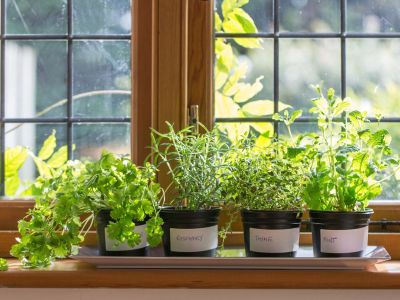Grow Herbs Indoors Year-Round: Simple Guide

Imagine having fresh, aromatic herbs at your fingertips, no matter the season. Picture the vibrant greenery of basil, the zesty scent of cilantro, and the soothing aroma of lavender, all thriving in your indoor herb garden. Whether you're an urban dweller with limited outdoor space or simply want to enjoy year-round herb growth, indoor herb cultivation is a rewarding and practical solution. Let's dive into the world of herb gardening tips and discover how to grow herbs indoors year-round.
Why Grow Herbs Indoors?
Growing herbs inside offers numerous benefits. Not only do you have a constant supply of fresh ingredients for your culinary creations, but you also enhance your indoor environment with natural air purifiers. Plus, indoor herb gardening can be a therapeutic hobby, bringing a touch of nature into your home.
Essential Tools for Indoor Herb Cultivation
Before you start, gather the essential tools for your indoor herb garden:
- Pots and Containers: Choose pots with drainage holes to prevent root rot.
- Potting Soil: Use well-draining, organic potting mix.
- Light Source: Natural sunlight is ideal, but grow lights can supplement.
- Watering Can: A small watering can with a fine nozzle is perfect for herbs.
- Fertilizer: Opt for a balanced, organic fertilizer to boost growth.
Choosing the Right Herbs
Not all herbs are created equal when it comes to indoor cultivation. Some thrive indoors, while others prefer the great outdoors. Here are a few herbs that do well inside:
- Basil: Loves sunlight and warmth.
- Chives: Easy to grow and tolerant of various conditions.
- Mint: Thrives in partial shade and moist soil.
- Parsley: Prefers bright light and consistent moisture.
- Rosemary: Needs plenty of sunlight and well-draining soil.
Setting Up Your Indoor Herb Garden
Location, Location, Location
Choosing the right spot for your herbs is crucial. Most herbs need at least 4-6 hours of sunlight daily. A south-facing window is ideal, but east- or west-facing windows can also work. If natural light is scarce, consider using grow lights to supplement.
Potting and Soil
Use pots with drainage holes to prevent waterlogging. Opt for a well-draining, organic potting mix. Ensure the soil is loose and aerated to promote healthy root growth.
Watering and Fertilizing
Water your herbs regularly, but avoid overwatering. A good rule of thumb is to water when the top inch of soil feels dry. Use a balanced, organic fertilizer every 4-6 weeks to provide essential nutrients.
Caring for Your Indoor Herbs
Light and Temperature
Herbs need plenty of light to grow. Aim for 6-8 hours of sunlight daily. If using grow lights, place them about 6 inches above the plants and keep them on for 14-16 hours a day. Maintain a consistent temperature between 65-75°F (18-24°C).
Humidity and Air Circulation
Most herbs prefer moderate humidity. If your home is dry, mist the plants occasionally or use a humidity tray. Ensure good air circulation to prevent mold and pests.
Pruning and Harvesting
Regular pruning encourages bushier growth. Pinch back the growing tips to promote branching. Harvest herbs as needed, but avoid taking more than a third of the plant at once.
Troubleshooting Common Issues
Yellowing Leaves
Yellowing leaves can indicate overwatering or insufficient light. Check the soil moisture and adjust watering habits. Ensure the plant is getting enough light.
Pests and Diseases
Common indoor pests include aphids, spider mites, and whiteflies. Use insecticidal soap or neem oil to control infestations. Prevent diseases by maintaining good air circulation and avoiding overwatering.
Slow Growth
Slow growth can be due to insufficient light, nutrient deficiency, or improper temperature. Adjust the lighting, fertilize regularly, and maintain optimal temperature.
Embrace the Joy of Indoor Herb Gardening
Growing herbs inside is not just about having fresh ingredients; it's about nurturing life and connecting with nature. The satisfaction of watching your herbs thrive and the delight of using them in your meals are unparalleled.
Conclusion
Indoor herb cultivation is a rewarding hobby that brings nature into your home. With the right tools, knowledge, and a bit of patience, you can enjoy year-round herb growth. Embrace the journey, and let your indoor herb garden flourish.
FAQs
What are the best herbs to grow indoors? Basil, chives, mint, parsley, and rosemary are excellent choices for indoor herb gardening.
How much light do indoor herbs need? Most herbs need at least 4-6 hours of sunlight daily. Supplement with grow lights if natural light is insufficient.
How often should I water my indoor herbs? Water when the top inch of soil feels dry. Avoid overwatering to prevent root rot.
Can I use artificial light to grow herbs indoors? Yes, grow lights can supplement natural light. Place them about 6 inches above the plants and keep them on for 14-16 hours a day.
How do I prevent pests and diseases in my indoor herb garden? Maintain good air circulation, avoid overwatering, and use insecticidal soap or neem oil to control pests.

 " width="250" height="250">
" width="250" height="250">By following these tips and embracing the joy of indoor herb gardening, you'll be well on your way to a thriving, year-round herb garden. Happy growing!
0 Response to "Grow Herbs Indoors Year-Round: Simple Guide"
Post a Comment